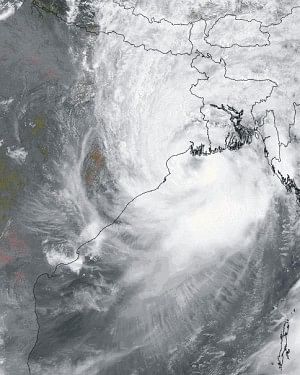Cyclone Aila and climate change

ACCORDING to the Associated Press, some 2.3 million people were affected by Aila, many of them stranded in flooded villages. Storm surges in Bangladesh flooded agricultural areas with salty water. Home to roughly 25,000 residents, the coastal island Nijhum Dwip was reported to be completely submerged. As of May 27, many rural villages had not yet been reached by relief workers, and the death toll was expected to rise significantly as search and rescue efforts continued.
As mentioned in Audity Falguni's article on June 01 in The Daily Star (entitled 'Aila after Sidr'), we should be thankful to the nature as the level of damage was far less this time, when compared to Cyclone Sidr of November, 2007. The death toll unofficially claimed to be about 200.
Now if we synthesize the most recent cyclone history, we seem to have already experienced three major cyclones -- Sidr in 2007, Bijli and Aila in 2009. Upon watching carefully, we can identify that a moderate La Nina event started in early 2007 and lasted for a long time before it started to gradually weaken in April 2009 with increasing chances for transition from La Nina to neutral conditions. Also, from a historical perspective, it has been observed that many other major cyclones that hit Bangladesh were in El Nino or La Nina years. So, the question can be raised now -- do El Nino/La Nina events intensify the threat of cyclone activities in Bangladesh?
The answer is yes, as there are reasons to believe that the influence of El Nino and La Nina events intensify the threat of Cyclone [Note that the terms El Nino and La Nina represent opposite extremes of the ENSO cycle. El Nino reflect periods of exceptionally warm sea surface temperatures across the eastern tropical Pacific while La Nina represent periods of below-average sea-surface temperatures across the eastern tropical Pacific. In general, El Niño indicates drier than average climate (like the drought in 1982-83 and 1998) and La Niña indicates wetter than average climate (like the flooding in 1988 and 1998) in Bangladesh]. To provide some background, presented below are the top cyclones (since 1960) and the activities of El Nino/La Nina events during those years:
May 28- 29 May, 1963: A severe cyclonic storm lashed Chittagong, Noakhali, Cox's Bazar and coastal islands of Sandwip, Kutubdia, Hatiya and Maheshkhali, killing about 11,520 people. A moderate El Nino event was active in the Pacific basin during that time. The onset of that El Nino event took place in the earlier part of 1963 and lasted for about three full years.
November 12, 1970: A cyclone hit the entire coast of Bangladesh with a maximum wind speed of 222-km per hour causing 10 to 20 feet of high tidal surge. The official death toll was 500,000, but the unofficial figure was about 120, 0000. A strong to moderate La Nina event was active during that time. Actually, the onset of that La Nina event occurred in the later part of 1970 and lasted until the earlier part of 1972.
May 24 -25, 1985: A severe cyclone hit Chittagong, Cox's Bazar, Noakhali and coastal islands causing 10 to 15 feet of high tidal surge, killing about 11,069 people. A moderate La Nina event was active during that time. The onset of that La Niña was in the later part of 1984 and lasted until the end of 1985. Then the El Nino event started in 1986.
April 29 -30, 1991: A cyclone hit Bangladesh at late night of April 29. The storm originated in the Pacific Ocean and reached the Bay of Bengal coast after 20 days. The maximum wind speed reached 225-km per hour. Official death toll was 150,000. A moderate El Nino event was active during that time. The onset of that El Nino event occurred in the later part of 1990 and lasted for about two full years.
November 29 -30, 1997: A cyclone hit Chittagong. The maximum wind speed was 224-km per hour. A strong El Niño event was very active during that time.
November 15, 2007: Cyclone Sidr is the fourth named storm of the 2007 North Indian Ocean cyclone season. The storm formed in the central Bay of Bengal, and quickly strengthened to reach peak sustained winds of 215 km/h (135 m/h). The storm eventually made landfall near Bangladesh on November 15. As it intensified to a Category 4-equivalent cyclone on November 15, thousands of emergency officials were put on standby in Bangladesh in advance of the storm's arrival. Massive evacuations of low-lying coastal areas also took place; a total of 650,000 people evacuated to emergency shelters. Approximately 3,447 deaths were blamed on the storm according to governmental sources. Agencies like Save the Children or Red Crescent Society claimed the number of deaths to be within 5,000 to 10,000 in Sidr. For the year 2007-08, a La Nina of moderate strength was established in the central and eastern Pacific. This La Nina event started to develop in January 2007 and it remained active until the end of 2008.
April 14-15, 2009: Cyclonic Storm Bijli was the first tropical cyclone to form during the 2009 North Indian Ocean cyclone season. The worst hit were the ports of Chittagong and Cox's Bazar, where Bijli brought heavy rain and wind gusts of up to 90 kilometers an hour. Officials said that hundreds of thatched houses were destroyed but that the damage was minimal, in part because of evacuation efforts. More than 200,000 residents took refuge in shelters, and authorities ordered boats to stay close to the shore. This was the time when La Niña started to gradually weaken with increasing chances (greater than 50%) for transition from La Niña to ENSO-neutral conditions.
May 25, 2009: Tropical Cyclone Aila hit Bangladesh. This is the time when the equatorial Pacific Ocean is expected to be transitioned from La Niña to ENSO-neutral conditions, ending the 2008-09 La Niña. However, the equatorial Pacific has been found to be warmed (i.e., El Niño like event) to the positive half of the neutral range, after weak La Nina conditions ended early last month. While most of the dynamic and statistical models forecast that during the May-July season there is an approximately 75% probability of maintaining ENSO-neutral conditions, some model forecasts stated that the probability for El Niño conditions rises to 45%.
The above chronology shows that most of the major cyclones that hit Bangladesh in different periods were either a year of El Niño or La Niña event, or a transitioning period from one to other event.
According to BBS (1993, 2002d), from a statistics of recorded cyclones over the last 200 years, it has been found that number of occurrences of major cyclones has drastically increased in the recent decades. While the number of cyclones was 3 during the period of 1795-1845 and 1846-1896 respectively, the number increased to 13 during 1897-1947 and 51 during the period of 1848-1998.
Also, as compared to 1950-1980 (we don't have any data related to El Nino/ La Niña events before 1950); the numbers of El Nino/ La Nina years have considerably increased in 1981-2009. This trend is likely to continue further, may be with more frequent El Niño/ La Niña events. Some scientists theorize that the increased level of El Nino/ La Nina events observed over the last few decades is, at least in part, the result of global climate change -- and the anticipated effects of climate change is the possible increase in both frequency and intensity of extreme weather events, such as cyclones, floods, and droughts.

 For all latest news, follow The Daily Star's Google News channel.
For all latest news, follow The Daily Star's Google News channel. 



Comments